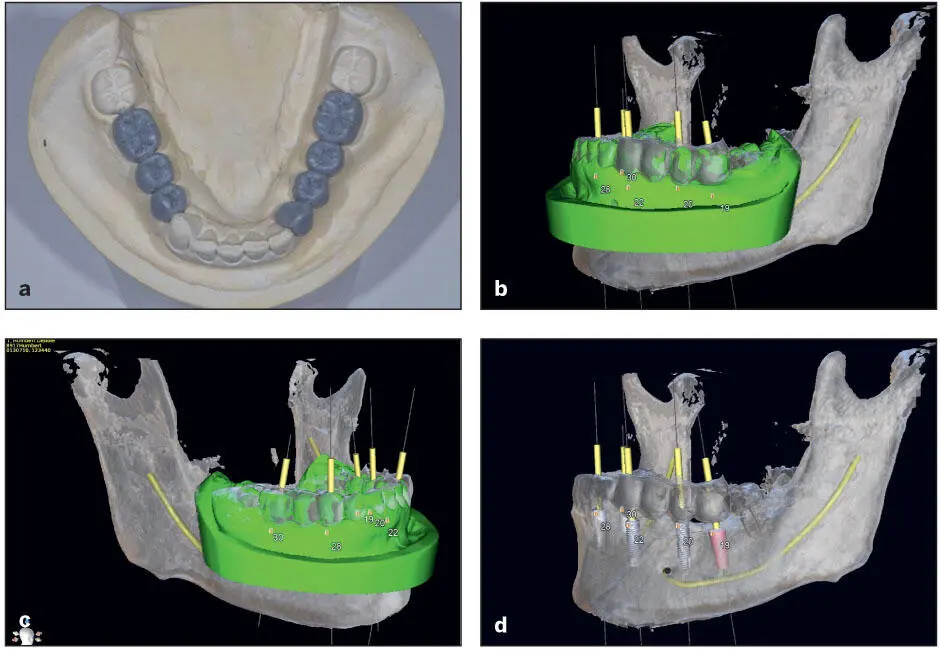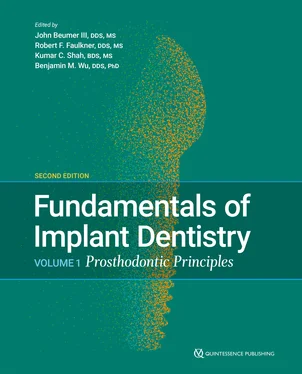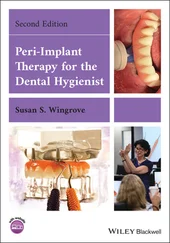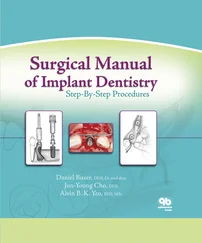The inaccuracies of digital impressions have been attributed to the steps of the scanning procedure. Because digital impressions are based on light emission on the scanned object, excessive light reflection from metal surfaces and saliva creates excessive image noise that influences the sharpness of the 3D image. 38, 39, 75In addition, areas that can obstruct light emission, such as proximal surfaces, should be scanned carefully, because shadowing will lead to loss of the entire shadowed area. 68, 76– 78Digital impressions require multiple overlapping images of the dental arch, which will eventually be stitched into one 3D image. However, each stitching process introduces an inevitable degree of error. 69, 76Therefore, partial-arch scanning (confined) where stitching is kept minimal has been found to be consistently more accurate than whole-arch scanning where extensive stitching is implemented. 69, 71, 76, 79, 80Specifically, the more terminal sites of the arch suffered from the greatest error. On the contrary, laboratory scanning of a conventional cast captures the whole arch dimension and does not require numerous image stitching, which may explain the greater accuracy of laboratory scanning for whole-arch recording. 72– 74, 76, 80Additional sources of error with the digital impression relate to its vulnerability to patient factors, such as patient and/or operator movement, access in the mouth, and soft tissue stability. 68, 81
Currently, for the partially edentulous situation, some laboratory studies have indicated that digital impressions of single implants or a few adjacent implants are comparable to conventional impressions, 62, 63, 65while other studies indicated the superiority of conventional impressions. 82, 83For full-arch implant impressions, digital impressions appear to be prone to errors. 70, 71, 84On the other hand, some recent laboratory studies have shown greater accuracy for digital impressions than conventional impressions. 64, 66, 67However, because these studies are laboratory studies, they may not truly reflect the challenges of intraoral scanning of implants, and clinically there are indications that digital impressions may suffer from greater errors 85; therefore, a form of accuracy verification should be considered. In conventional impressions, it is recommended to have a verification jig/index to confirm the accuracy of the final master cast. In the digital workflow, this step is not available, and the use of an analog prototype is needed to verify passive fit prior to the fabrication of a larger prosthesis.
If intraoral digital impressions are to be incorporated into the digital workflow on a wide-scale basis, it is imperative that clinicians abide by the necessary techniques to ensure the accuracy of transferring the data. As digital technology continues to improve, it is conceivable that digital impressions will become a reliable method for recording and transferring the data to the laboratory, thereby enhancing the digital workflow.
3D planning and digital workup
The traditional prosthodontic workup has been accomplished with conventional measures such as mounting diagnostic casts on an articulator, the wax-up, and the teeth setup on trial denture bases. The early application of digital implant dentistry to design the restoration was based on scanning the wax-up. 86As per the traditional workup, the diagnostic casts are mounted on a semiadjustable articulator in centric relation. This is followed by a diagnostic wax-up to determine the prosthetic design. The casts are then scanned both with and without the diagnostic wax-up and are virtually articulated. These data sets are then merged with the CBCT data in a treatment planning software ( Fig 5-14).

Fig 5-14 (a) Analog wax-up on study cast. (b and c) Analog wax-up scanned and superimposed on the CBCT data in a 3D planning software. (d) Verification of final implant positions and distance to the inferior alveolar nerve.
More recently, the fully digitized wax-up has become a reliable option for implant treatment. Virtual arches can be generated by scanning the physical casts or after digital impression. Digital wax-ups involve the addition of virtual teeth to establish the ideal implant position. The implant site is visualized in 2D and 3D views, and the implant placement can then be virtually planned based on the prosthetic design. Once accomplished, a determination is made whether to place the implant using fully guided, semiguided, or freehand surgery. The use of guided surgery is strongly recommended to further enhance the patient outcome. In addition, the digital wax-up can be used to virtually design the prosthetic implant components and definitive restorations, where the full design of the abutment, framework, and restoration is determined digitally via the software. Currently, several software programs are available to facilitate the implant planning. Some of them are closed systems related to specific implant manufacturers, while others are open programs and allow for planning of the implants from different manufacturers.
Complete digital determination of the prosthesis has been found to be advantageous because it is totally reversible, which simplifies the determination of the restoration contour. The use of the automated features of the software reduces the planning time and the dependence on technical skills for producing wax-ups and tooth setups. 87– 89In addition, the software is commonly linked to a “library” of digital teeth that can be used for the digital wax-up. 89– 92Digital molds are based on anatomical and esthetic teeth, which may explain why several studies have found the digital protocol produces very esthetic and anatomical teeth with good natural details that are at least as good as what the dental technician can produce using a traditional wax-up. 90Digital modeling of the restoration also ensures completely symmetric anatomy, as the software can reliably implement mirroring of the contralateral tooth or restoration ( Fig 5-15). 88, 93
The type of abutment to be used can be determined at the time of digital treatment planning. The optimized visualization of the prosthetic components has increased the reliability of prosthesis design and selection. For example, premachined transmucosal abutments—including predetermined angle corrections—that best support the prosthesis can be reliably selected (see Fig 5-15e). In addition, the software ensures ideal prosthesis thickness is implemented so the proposed prosthesis exhibits ideal mechanical properties.
Despite all of these advantages, the digital protocol still requires refinement of the establishment of occlusal contacts, which currently appears to be inferior to the conventional protocol. In complex full-arch restorations, a clinical remount is absolutely necessary (see Figs 5-15gand 5-15h). This has been attributed to the accumulated accuracy errors of the scanned image and virtual articulation. 94– 97Nevertheless, for implant planning and diagnostic wax-up, minor occlusal discrepancies may not have major consequences. For definitive prostheses, physical casts can still be used by the technicians when they are completing the veneering around the restorations to ensure good occlusal and proximal contacts. Alternatively, if the clinician is following a completely digital protocol, the physical casts can be produced by 3D printing, which allows the dental technician to stain and glaze the restoration and accurately refine the occlusal and proximal contacts. In some instances, routine digital workflow does not allow actual try-in of the prosthesis before processing, which can lead to patient dissatisfaction. 89This can be overcome by generating a trial prosthesis (prototype) that can be modified by the clinician to meet the patient’s demands. Thus, while the software tools will facilitate the treatment, the clinician should be aware of the limitations and know that these technologies do not replace sound prosthodontic principles and skills.
Читать дальше













